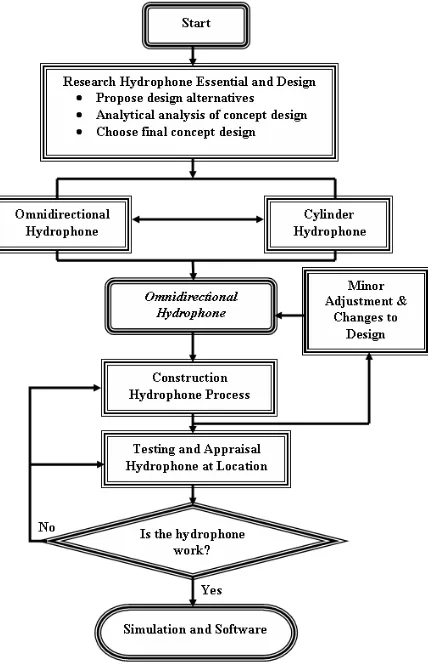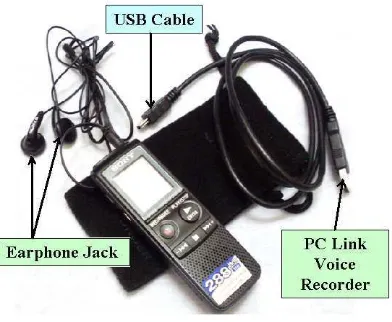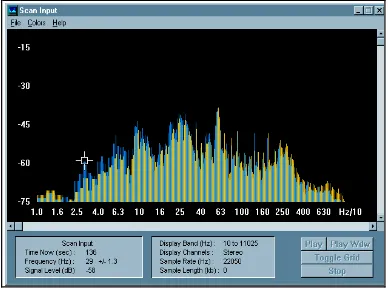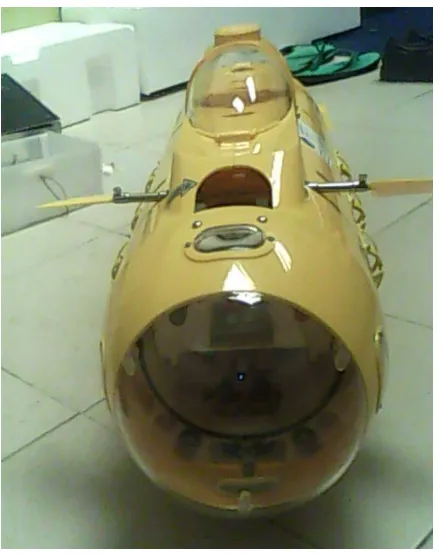Development of Hydrophone Sensor System for
Autonomous Underwater Vehicle Application
M Shahrieel M Aras 1 ,Mazleenda Mazni 2 , Hendra Hairi3
, M.Herman Jamaluddin4
1 Faculty of Electrical Engineering,Universiti Teknikal Malaysia Melaka, Email: [email protected] 2 Faculty of Electrical Engineering,Universiti Teknikal Malaysia Melaka, Email: [email protected]
3 Faculty of Electrical Engineering,Universiti Teknikal Malaysia Melaka, Email: [email protected] 4 Faculty of Electrical Engineering,Universiti Teknikal Malaysia Melaka, Email: [email protected]
Abstract- This project is about developing a hydrophone sensor system for the purpose of autonomous underwater vehicle (AUV) application. AUV is an underwater vehicle which travels underwater. Hydrophone is an underwater microphone which with the help of pressure impulses of acoustic waves converts them into electrical signals which in further are used for communication. It was designed to be used underwater for recording or listening to underwater sound. Hydrophone needs an audio recorder to analyze the spectrographic analysis, without necessary to carry the computer into hostile marine environment. Spectrogram is used to simulate the sound signal of underwater sounds. Spectrogram is a plot of the frequency component such an audio signal as function of time. In this spectrogram program, digital audio recording are analyzed to produce a plot of frequency versus time, with harmonic intensity represented by a variable color scale. Then, the hydrophone system is tested by recording the underwater sound signals at the location to make sure that the system in good condition.
Keywords: Hydrophone; Autonomous Underwater Vehicle
(AUV); Spectrographic; Acoustics
I. INTRODUCTION
Underwater acoustics is the study of the propagation of sound in water and the interaction of the mechanical waves that constitute sound with the water and its boundaries [1]. Figure 1 shows an underwater acoustics propagation.
Figure 1. Underwater Acoustic Propagation [1]
Nowadays, many universities all over the world are competing with custom made Autonomous Underwater Vehicles (AUV) to aiming to participate with a small submarine in the future. An Autonomous Underwater Vehicle (AUV) is a robotic device that is driven through the water by a propulsion system, controlled and piloted by an onboard computer, and maneuverable in three dimensions [2]. This level of control, under most environmental conditions, permits the vehicle to follow precise preprogrammed trajectories wherever and whenever required. There are many applications of AUV which are use for commercial, military, and underwater research [3]. Thus, this project just focuses on the underwater or marine research for the future study. In primarily oceanographic tools, AUV carry sensors to navigate autonomously and map features of the ocean. A typical sensor includes compasses, depth sensors, sidescan, hydrophone, sonars, magnetometers, thermistors and conductivity probes.
Hydrophone is an electronic device or called it as underwater microphone which with the help of pressure impulses of acoustic waves converts them into electrical signals used for communication. It was designed to be used in underwater for recording or listening to underwater sound [4]. For this project, hydrophone system is used in AUV application for monitoring and surveying application. The hydrophone system must be in excellent condition, so it proven by develops the hydrophone system including of the process to record and produce the database of underwater sounds in Malaysia.
II. PROJECT DEVELOPMENT
Figure 2. Design and construction of project
A Omni directional Hydrophone
Hydrophone is based on a piezoelectric transducer that produces electricity when subjected to a pressure change. Piezoelectricity is the ability of some materials to generate an electric field in response to applied mechanical stress. Then, a transducer is an electrical device that can converts water pressure into an electrical form.
Omni directional hydrophone is a spherical shell transducer which is formed of two hemispherical shells bonded together. It has inner and outer metal films radically aligned in quadrature to define eight discrete sections sensitive to impinging and acoustic energy to generate representative signals. This type of hydrophone have many advantages such as dielectric substance, contain in shielded, provides a broadband and highly sensitive to underwater sound vibrations. Because of that reason, the Dolphin Ear DE2000 Series Hydrophone is applied in this project. Figure 3 shows the Dolphin Ear DE2000 Series Hydrophone and their specification as shown in Table 1.0.
Figure 3. Dolphin Ear DE2000 Series Hydrophone
TABLE 1.
SPECIFICATION OF DOLPHIN EAR DE 2000 HYDROPHONE
B Voice Recorder
Figure 4. Sony ICD-PX720 Audio Recorder
TABLE 2.
SPECIFICATION OF SONY ICD-PX720 AUDIO RECORDER
C Spectrogram
Spectrogram software is used to simulate the sound signals that obtain from underwater. It allows us to observe underwater sounds and analyze their content. This software produces graphics similar to the type of ‘waterfall display’ used by SONAR operators on U.S Navy Nuclear Submarines to detect and identify underwater sounds [4]. Spectrogram uses a mathematical Fast Fourier Transform (FFT) to perform the frequency analysis. FFT is an efficient algorithm to compute the Discrete Fourier Transform (DFT) and its inverse. FFT's are usually specified by the number of input data points used in each calculation, which are always powers of two
such as 512, 1024, 2048, and ect. The frequency resolution of the spectrogram is always the digital sampling rate of the audio signal divided by the number of FFT data points. Because of that, the greater the number of FFT data points, the finer the frequency resolution of the spectrogram.
It is not a complex combinations of individual frequency components or harmonics but it is a simply plot of the frequency components of such an audio signal as function of time. It use WAV format which is a digital audio recordings format. When the signal is analyzed, it produces a plot of frequency versus time, with harmonic intensity and represented by variable color scale.
D Spectrogram Display
The spectrogram display reveals the audio signal as a frequency versus time plot with signal amplitude at each frequency represented by intensity or color. From this spectrogram display, the continuous readout of time (milliseconds), frequency (Hz) and signal level (dB) at the position of the mouse pointer (cursor) is displayed at the bottom left of the display. A coordinate grid can also be added or removed by clicking the "Toggle Grid" button at the bottom right of the display. The spectrogram display is shown in Figure 5.
Figure 5. Spectrogram Display
E Scope Display
Figure 6. Scope Display
III. RESULTS
There are 2 system is performed for this project. It will be divided into two part of system. Figure 7 shows the hydrophone system for AUV which are hydrophone and monitoring. The sound signals will be obtain by placing the Omni directional hydrophone into underwater. After that, the sound signals are recorded by voice recorder and save the digital recording into hard disk of laptop or computer. Then, the sound signal is analyzed by using Spectrogram software. After that, the system is applied to the Autonomous Underwater Vehicle as shown in Figure 8.
Figure 7. Hydrophone System for AUV
Figure 8. Applying the Hydrophone System to AUV
The hydrophone system is tested and applied in order to make sure there is in good condition. Therefore, the hydrophone system is tested in Rumah Akuarium, Taman Botanikal, Air Keroh Melaka. The underwater species are Puyu, Lampam Sungai, Krai, Silver Dollar,
Kelah, Baro Brad Oscar, Sebarau, Tortoise, Tiger Borb,
Kalai, and Patin. Figure 9 shows the Spectrogram of Tortoise.
Figure 9. Spectrogram of Tortoise
Figure 10. Spectrogram for Passive Area
Figure 10 shows the spectrogram for an underwater in passive condition. After that, data will be use to provide the sampling rate of underwater species in details. Figure 11, 12 and 13 shows the real AUV that will be attached with hydrophone sensor system.
Figure 11. An AUV (top view)
Boat amplifier and data recorder
Hydrophone
Figure 12. An AUV (side view)
Figure 13. An AUV (front view)
IV. CONCLUSION
The details structure of the project have been discussed and shown in previous chapter. The explanation about the process to develop the hydrophone system has been outlined in this report. Then, the results and problem finding also have been described. Therefore, based on the research made, a brief project conclusion of
the development of hydrophone sensor system for Autonomous Underwater Vehicle proposed is given.
Hydrophone is an underwater microphone that used for recording and listening the underwater sound. Autonomous Underwater Vehicles (AUVs) are robotic submarines. They are a part of the emerging field of autonomous and unmanned vehicles. For this project, hydrophone is used in AUV application for monitoring and surveying. The hydrophone must be in excellent condition, so it proven by developed the hydrophone system. The hydrophone system is including of process to record the underwater sound. Then, the underwater sound is simulated into sampling rate frequency to produce the data bank of underwater sound in Malaysia. The difficulties accruing in such a process are discussed and the possible methods to overcome these problems are proposed and discussed.
ACKNOWLEDGEMENT
We wish to express our gratitude to honorable Faculty of Electrical Engineering, Universiti Teknikal Malaysia Melaka especially to higher management for give the financial as well as moral support complete this project successfully.
REFERENCES
[1] Underwater_acoustics. Retrieved on October 2009 from
http://en.wikipedia.org/wiki/Underwater_acoustics
[2] C. von Alt, “Autonomous Underwater Vehicles Prepared for the Autonomous Underwater Lagrangian Platforms and Sensors Workshop,” Woods Hole Oceanographic Institution March 24-26, 2003
[3] Autonomous Underwater Vehicle. Retrieved on September 2009 from
http://en.wikipedia.org/wiki/Autonomous_underwater_vehicl e
[4] Hydrophone. Retrieved on September 2009 from
http://en.wikipedia.org/wiki/Hydrophone
[5] Underwater_acoustics. Retrieved on October 2009 from
http://en.wikipedia.org/wiki/Underwater_acoustics
[6] Appendix C, “Underwater Sound Concepts”, Undersea Warfare Training Range, C1-C13.[online], 2009. Available:
http://projects.earthtech.com/uswtr/EIS/FOEIS-EIS_2009/FOEIS-EIS_2009.htm
[7] Hearing Range. Retrieved on October 2009 from
http://en.wikipedia.org/wiki/Hearing_(sense)
![Figure 1. Underwater Acoustic Propagation [1]](https://thumb-ap.123doks.com/thumbv2/123dok/610758.73120/1.612.94.287.585.696/figure-underwater-acoustic-propagation.webp)



